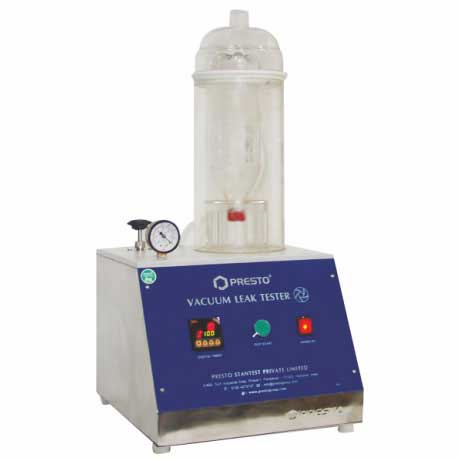How Do You Perform A Vacuum Leak Test For HDPE Bottles?

HDPE bottles have been widely used in the bottle industry due to their durability and versatility in various industries. However, it is imperative that these bottles undergo rigorous testing for vacuum leakage. Thus, we at Presto being the leading manufacturer of bottle testing instruments has designed one of the high-quality testing equipment known as a vacuum leak tester for bottles. This is one of the high-quality testing equipment that can be used in different industries to test containers and bottles against vacuum leakage.
It has been designed as per testing standards including ASTM D 4991–07(2015), ASTM F 2338–09(2013), ASTM D6653, ASTM D3078 and ASTM D5094. This will ensure accuracy in test results and make manufacturers confident in their product quality. In this blog, we will discuss brief information about the Presto Vacuum Testing Machine and why HDPE bottles should be tested against vacuum leakage.
Importance of testing HDPE bottle product quality before delivery
HDPE bottles, commonly used for packaging various products, are a crucial component in ensuring the safety and integrity of the contents they hold. As such, it becomes imperative to subject these bottles to rigorous testing for product quality. Testing the quality of these HDPE bottles is important to ensure that they meet regulatory requirements.
By prioritizing comprehensive product quality checks for HDPE bottles throughout their lifecycle — from design to production — we can instil confidence among buyers involved while maintaining consumer satisfaction at its highest level.
You can easily maintain the product integrity of HDPE bottles by using a Presto vacuum leak tester. This quality lab testing instrument will easily help the manufacturers in testing the vacuum leaks in bottles and ensuring that quality materials will be delivered to the customers.
Now, let us discuss brief information about the Presto vacuum leak tester for bottles.
A brief about Presto vacuum leak tester for bottles
The Presto vacuum leak tester for bottles is a state-of-the-art lab testing instrument that has been designed to ensure the integrity of bottle packaging. It is equipped with a microprocessor-based timer, guaranteeing accuracy and repeatability in testing results.
This bottle testing instrument meets the stringent requirements outlined in the USP 28 packaging practice specification, ensuring compliance with industry standards. Manufacturers can easily conduct vacuum leak testing of bottles and ensure that quality materials will be delivered to the customers.
With its user-friendly vacuum mechanism, sample testing becomes a simple and efficient process. This testing instrument incorporates features such as inlet vacuum pressure setting and pre-sets timer functions, allowing users to customize testing parameters according to their specific needs.
Furthermore, the changeable timer units provide flexibility by enabling the display of testing durations in hours, minutes, or seconds. The inbuilt calibration facility ensures consistent and precise testing by allowing periodic calibration of this testing equipment.
You can easily take advantage of a vacuum leak tester to test bottles efficiently. Now, let us discuss briefly the features and technical specifications of this quality testing equipment.
Features of Presto vacuum leak tester
There are various features one can get with the use of Presto vacuum leak tester for bottles and by using this high-quality testing instrument the manufacturers of the bottle industry can deliver leak-resistant products to the customers.
Below we have listed the features of this quality testing equipment:
- Microprocessor-based timer for accuracy and repeatability
- Meets USP 28 Packaging Practice specification
- Sample testing through an easy vacuum mechanism
- Inlet Vacuum Pressure setting and Pre-set Timer functions incorporated
- Changeable Timer Units in Hrs:min: sec
- Inbuilt Calibration facility
- Vacuum gauge for easy pressure monitoring
Now, let us discuss briefly the technical specifications of this quality testing equipment.
Technical specifications of vacuum leak tester for bottles
- Display: Digital
- Vacuum adjustable up to — 800 MB (-600 mm-Hg.)
- Chamber made of polished transparent PMMA (very rugged)
- Least Count: 10 mm Hg
- Power: 220V, Single phase, 50 Hz
- Controls: Digital for pressure monitoring and timer
- Timer: Digital preset up to 999 seconds (Changeable to Hrs:min: sec)
- Material: Mild Steel/ Stainless Steel
- 2-stage vacuum and holding time setting
- Accuracy: 0.5% of the measure
- Delivered with vacuum generator
- Customized Box with dimensions upon request
- Finish: Powder-coated Havel Gray & Blue combination finish and bright chrome/zinc plating for a corrosion-resistant finish
With these features and technical specifications, one can easily conduct a vacuum test on bottles with this high-tech vacuum leak tester.
Now, let us discuss a brief about the working of this testing instrument for testing vacuum leaks in bottles.
How HDPE bottles should be tested against vacuum leaks with a vacuum leak tester?
If you want to conduct an HDPE bottle vacuum test then you can easily follow the steps mentioned below.
- Turn ON the machine by plugging the mains socket of the machine into a 3-pin 15 amp socket and set the test duration timings.
- After setting the digital timer, remove the desiccator cover and place the sample bottle inside the test cavity in an inverted position.
- After placement of the sample bottle, put the cover back on the desiccator. Make sure it will be properly placed on the gasket.
- After proper placement of the bottle sample, turn the inlet knob to a close position.
- Once all the above steps will be followed, you can easily commence the test.
In this way, you can easily test the HDPE bottles against vacuum leaks. If you want a live demo for the use of this quality testing equipment, then you can give us a call at +919210903903 or email us at info@prestogroup.com. Our team of technical experts will consult you regarding all your needs and queries.
Source of Content: How Do You Perform A Vacuum Leak Test For HDPE Bottles?

